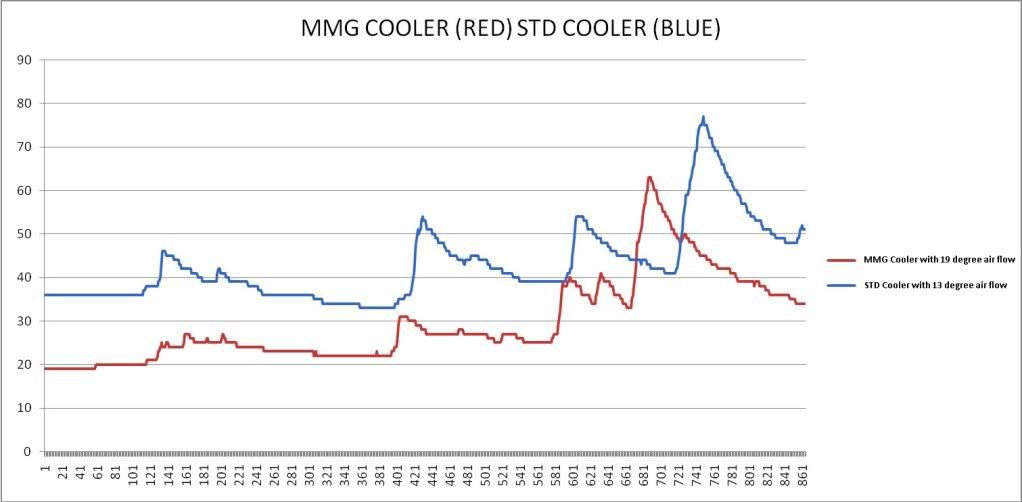Edited by turbobob, 29 March 2011 - 12:44 PM.

MMG Intercooler
#1

Posted 29 March 2011 - 12:29 PM
#2

Posted 29 March 2011 - 12:34 PM
#3

Posted 29 March 2011 - 12:34 PM
#4

Posted 29 March 2011 - 12:40 PM
Spuk, I gather that a stage 1.5 setup would see the biggest gain from the new intercooler.
#5

Posted 29 March 2011 - 08:28 PM
Link to group buy
Spuk, I gather that a stage 1.5 setup would see the biggest gain from the new intercooler.
#6

Posted 30 March 2011 - 07:06 AM
Do it, you know you want to
Link to group buy
Spuk, I gather that a stage 1.5 setup would see the biggest gain from the new intercooler.FFS don't tempt me, I've just got back from skiing and have a rather expensive trip to USA coming up...
#7

Posted 30 March 2011 - 02:41 PM

Edited by turbobob, 30 March 2011 - 02:41 PM.
#8

Posted 30 March 2011 - 05:55 PM
#9

Posted 30 March 2011 - 08:31 PM
#10

Posted 30 March 2011 - 08:33 PM
#11

Posted 30 March 2011 - 09:51 PM
1. The initial intake temperature (into the engine) at the start of the run is 17C lower than the OEM intercooler, but with the additional 6C ambient air temperature that makes an overall improvement of 23C.
2. The performance of the larger intercooler actually maintains this beneficially lower intake temperature, therefore is providing an overall benefit throughout its use. Therefore actually being more use.
The reason that the spikes will occur and heat soak will remain is because there is no way that it can be completely removed. As the turbo spools it will produce a fcuk load of heat and that cannot be dispersed immediately as the intercooler will require the speed of the coolant to catch up with the increase in heat and then pull the temperatures back down.
Now correct me if I am wrong, but from looking at the chart overall... There should be a benefit of increased power (if only quite small) based on the reduction in inlet air temperatures... hence TurboStreisand noticing a change. And if the change is 3% at 12C then thinking that a gain of around 5-6bhp on a basic 200bhp would be reasonable and 15-18 on a 300bhp engine (subject to power and heat produced by the turbo having a linear relationship).
Also if that is over a period of 14minutes (or 840 seconds) then that would be useful benefit. However my understanding of a chargecooler system would be that it would be slower to increaswe
Edited by Mangham54, 30 March 2011 - 09:55 PM.
#12

Posted 31 March 2011 - 10:48 AM
This isn't the intercooler as used on the Stage 4. This is the intercooler for standard Turbo up to a stage 3. It's not comparing like for like, or comparing equivalents.The way I'm reading it the X axis will be time. 4 lots of peak (presumably) boost showing lower temps with the uprated intercooler but also showing the heat soak starting to take effect with the 4th run in both cases.
Would love to see a charge coolers effect on there as well.
Sorry for the misuse of the nomenclature, if you're reading Mr Borg.
I think Mangham54 has pretty well highlighted the differences.Would be useful to also see the engine revs, speed and throttle position plots too, to help get an idea of how quickly the temperatures are building up and equally importantly, how quickly the system is dissipating the heat. To be honest, looking at that graph, the intake temperatures are building up just as quickly in both and dissipating at much the same rate. The only major difference is the red line is starting from 15-20 degrees cooler. Rebase both lines to be equalt at the start of the run and they would look much the same.
Not out to diss the product at all, but having been there and believed the marketing claims about a poorly designed charge cooler system, I was very dissapointed after logging my own data on track and road acceleration runs.
Having all the data logging each run would help understand where the real benefits are and quantify the level of improvement over the standard IC.
I would add that this intercooler is almost identical in size to the standard intercooler so the peaks would be pretty similar. However you can't argue with the temperature drops.
#13

Posted 31 March 2011 - 11:29 AM
1. Also if that is over a period of 14minutes (or 840 seconds) then that would be useful benefit. However my understanding of a chargecooler system would be that it would be slower to increaswereactinitially to temperature increase from the turbo, due to a much larger amount of coolant.
2. But a chargecooler would suffer more with lower (average) road speeds with aggressive acceleration (fast road rather than trackday) as the coolant would never receive enough airflow after passing a long way down to the front of the car (by which the revs will be lower so coolant flow would be reduced) and getting back to the turbo housing or inlet manifold (or whatever it is that it is cooling).
3. However for tracking a large volume radiator at the front of the car, with the much greater flow of high velocity air over a lengthier period of time would be more beneficial for track days, when overall speeds are likely to be higher.
I've broken your points down in to groups of related questions
1. Water is much more efficient transfer medium so it will transfer more heat energy than Air-Air, so there is more heat that has to be rejected by the reservoir and secondary circuit. The bigger the reservoir the more energy capacity and the longer it takes to heat soak the system.
2. The coolant flow is driven by an electric circulator and gives a constant flow to the radiator and reservoir. The coolant supplied to the heat exchanger is at ambient temperature. The degree of predictable intake temperatures allows the ecu to run optimal ignition timing and fueling based on demand. For road use you see this as better driveability and better mpg.
3. Consider that the front rad is multipass, is in the optimal location for airflow, is also several times the frontal area of a engine bay mounted intercooler and that all heat is then rejected to outside of the system, a sidepod intercooler of any design has none of these advantages.
#14

Posted 31 March 2011 - 12:39 PM
1. Water is much more efficient transfer medium so it will transfer more heat energy than Air-Air, so there is more heat that has to be rejected by the reservoir and secondary circuit. The bigger the reservoir the more energy capacity and the longer it takes to heat soak the system.
However the chargecooler has to transfer air->water->air whereas intercooler only does air->air so there is efficiency lost via the extra transfer, or am I talking rubbish?
#15

Posted 31 March 2011 - 01:11 PM
Edited by turbobob, 31 March 2011 - 01:11 PM.
#16

Posted 31 March 2011 - 01:22 PM
And having the heat exchanger at the front is the same place where the engine radiator is, so you are dumping the heat in the area where the engine is dumping its heat.
both rads are doing the same thing , but at different temperature ranges, the engine rad will want a temperature delta in the range of 80-90 and the warm waft of used air from the chargecooler rad is more than able to do this.
#17

Posted 31 March 2011 - 06:25 PM
Well, you can, which is why I suggested seeing the speed, rev and throttle position grpahs as well. All the above graph shows is the red run started from a cooler intake temp than the blue run. What we don't know is what happened before the run. Was the standard car doing more acceleration runs resulting in higher temps at the start. If both cars went through an identical set-up and pre-run procedure then yes, it is cooling more efficiently than standard.
I would add that this intercooler is almost identical in size to the standard intercooler so the peaks would be pretty similar. However you can't argue with the temperature drops.
I've learned tha hard way to be cynical and question results. To me, it still looks like under acceleration, bith systems are operating much the same if you disregard the difference in temps at the start of the run. Just needs more data to quantify the real-world benefits I think.
#18

Posted 31 March 2011 - 06:29 PM
Siztenboots, I don't know why you are stoking this debate up again. It's been done to death - search is your friend
You beat me to it Spuk. Intercooler systems are more efficient that charge coolers. Because as you say with an charge cooler its air - metal - water - metal - air. With an intercooler its air - metal - air.
Also charge coolers may take longer to reach soak temp, but the more coolant you have, the more stored energy you have, the longer it takes to dissipate the heat.
And having the heat exchanger at the front is the same place where the engine radiator is, so you are dumping the heat in the area where the engine is dumping its heat.
It may be air-metal-water-metal- but you dont have to wait for the whole process to happen. So its basically air-metal-water and then that fooks off around the system leaving the next air-metal-water to happen straight away. And as water absorbs heat alot better then happy days.
Also even after alot of running you'd be lucky to increase the water in the cc system by a few degrees
#19

Posted 31 March 2011 - 06:48 PM
They were both the same runs.
Well, you can, which is why I suggested seeing the speed, rev and throttle position grpahs as well. All the above graph shows is the red run started from a cooler intake temp than the blue run. What we don't know is what happened before the run. Was the standard car doing more acceleration runs resulting in higher temps at the start. If both cars went through an identical set-up and pre-run procedure then yes, it is cooling more efficiently than standard.
I would add that this intercooler is almost identical in size to the standard intercooler so the peaks would be pretty similar. However you can't argue with the temperature drops.
I've learned tha hard way to be cynical and question results. To me, it still looks like under acceleration, bith systems are operating much the same if you disregard the difference in temps at the start of the run. Just needs more data to quantify the real-world benefits I think.
There was no under acceleration. Both runs were with full throttle. And you can't dis-regard the starting intake temps for two reasons. The replacement intercooler is obviously working as the temp is lower. And secondly, the ambient temps was higher for the replacement intercooler, yet it was still significantly less than the standard intercooler.
#20

Posted 31 March 2011 - 06:52 PM
Unless the water coming back in is hot. And the heat exchange may done in a different place, but there is still the air - metal - water - metal - air. So it isn't as efficient as an intercooler.
Siztenboots, I don't know why you are stoking this debate up again. It's been done to death - search is your friend
You beat me to it Spuk. Intercooler systems are more efficient that charge coolers. Because as you say with an charge cooler its air - metal - water - metal - air. With an intercooler its air - metal - air.
Also charge coolers may take longer to reach soak temp, but the more coolant you have, the more stored energy you have, the longer it takes to dissipate the heat.
And having the heat exchanger at the front is the same place where the engine radiator is, so you are dumping the heat in the area where the engine is dumping its heat.
It may be air-metal-water-metal- but you dont have to wait for the whole process to happen. So its basically air-metal-water and then that fooks off around the system leaving the next air-metal-water to happen straight away. And as water absorbs heat alot better then happy days.
Also even after alot of running you'd be lucky to increase the water in the cc system by a few degrees
But this intercooler isn't about intercooler vs chargecooler. It is a drop in replacement for the standard intercooler. The intercooler fitted to the car as it came out of the factory is shit. This is an intercooler that is practially the same size as the standard intercooler yet actually works properly for a standard turbo up to stage 3.
For stage 4, there is a bigger MMG intercooler.
Edited by turbobob, 31 March 2011 - 06:53 PM.
1 user(s) are reading this topic
0 members, 1 guests, 0 anonymous users




















